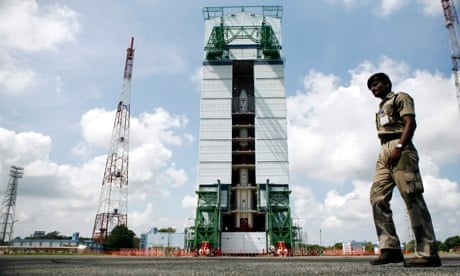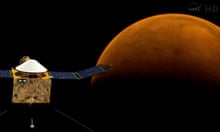The cyclone season is almost over, the planets are in alignment, the countdown has started. On Tuesday at 2.46pm local time, a rocket will blast off from the Indian space port on a small island in the Bay of Bengal, heading for Mars.
Its course will be closely followed. The $70m (£45m) mission – India's first attempt to reach the red planet – aims not just to gather information that might indicate if life has ever existed or could exist there, nor simply to showcase Indian technology, but to steal an interplanetary march on its regional rival, China.
"In the last century the space race meant the US against the Soviets. In the 21st century it means India against China," said Pallava Bagla, one of India's best known science commentators. "There is a lot of national pride involved in this."
That the mission was about national pride was never in doubt. It was announced last year by prime minister Manmohan Singh in his annual address from the battlements of Delhi's famous Red Fort, the bastion of the Mughal emperors. Its success would mean the Indians would join the Russians, the US and the European space agency which have all also reached Mars.
A plunging currency, ailing economy and the state's seeming inability to deliver basic services have led many Indians to question whether their nation is quite as close to becoming a global superpower as it seemed in the heady years of the last decade when economic growth pushed the 10%. For a government beset by charges of corruption and mismanagement, the Mars mission is one way to repair its battered image. It was announced in the week more than 600 million people were hit by the world's worst power cut.
Such expenditure is, however, controversial, with some questioning whether India, where more than 40% of children are malnourished and half the population have no toilets, can afford the mission. One development economist called it a symptom of "the Indian elite's delusional quest for superpower status".
Critics of Britain's aid programme in the country have also been angered by the mission. The UK gives India around £300m each year.
But Pallava said such criticism befuddled him. "Really the money involved is tiny compared to other expenditures," he said.
Successive Indian governments have invested heavily in the country's space programme, making it one of the most capable in the developing world. The task of the Indian Space Research Organisation (ISRO) team is extraordinarily technical, involving huge numbers of complex calculations of the trajectory and speed of the rocket, the satellite and planets.
Indian scientists say they are optimistic that it will be successful.
"This is a very complicated mission but we have the capability to do it. We have developed new knowledge and we are very confident that we can achieve the navigation from earth to Mars accurately and properly," said ISRO chairman Dr K Radhakrishnan.
So far success in the race against the Chinese has proved elusive, with Beijing's scientists achieving a manned space mission in 2003 and beating India by placing a satellite in the moon's orbit in 2007. The mission to launch the Mangalyaan, or vehicle to Mars, has not been without its problems. The failure of India's most powerful rocket, the first choice to hoist the heavy satellite into space, has necessitated the full deployment of what is arguably India's greatest talent – improvisation, or jugaad, as it is known locally.
Instead of sending their mission directly to Mars, the ISRO plans to place its satellite in the earth's orbit first, and then use the momentum generated through a series of complex manoeuvres to send the device towards its final destination. If all goes well, it will reach the planet sometime next summer.
The scientists will also have to hit a five-minute window for the launch. If they miss it, they will have to wait another two years – or possibly five – for another chance.










Comments (…)
Sign in or create your Guardian account to join the discussion